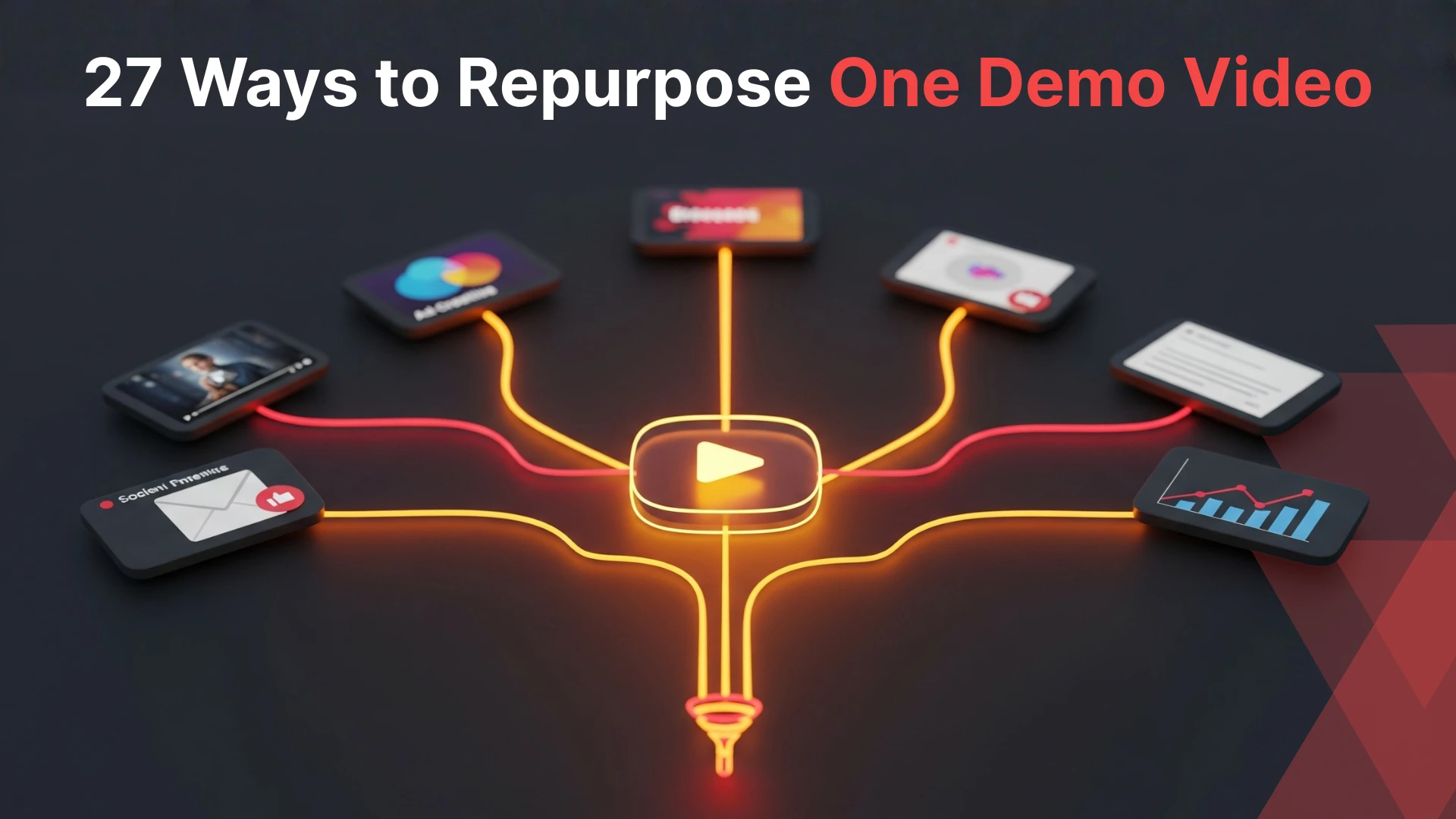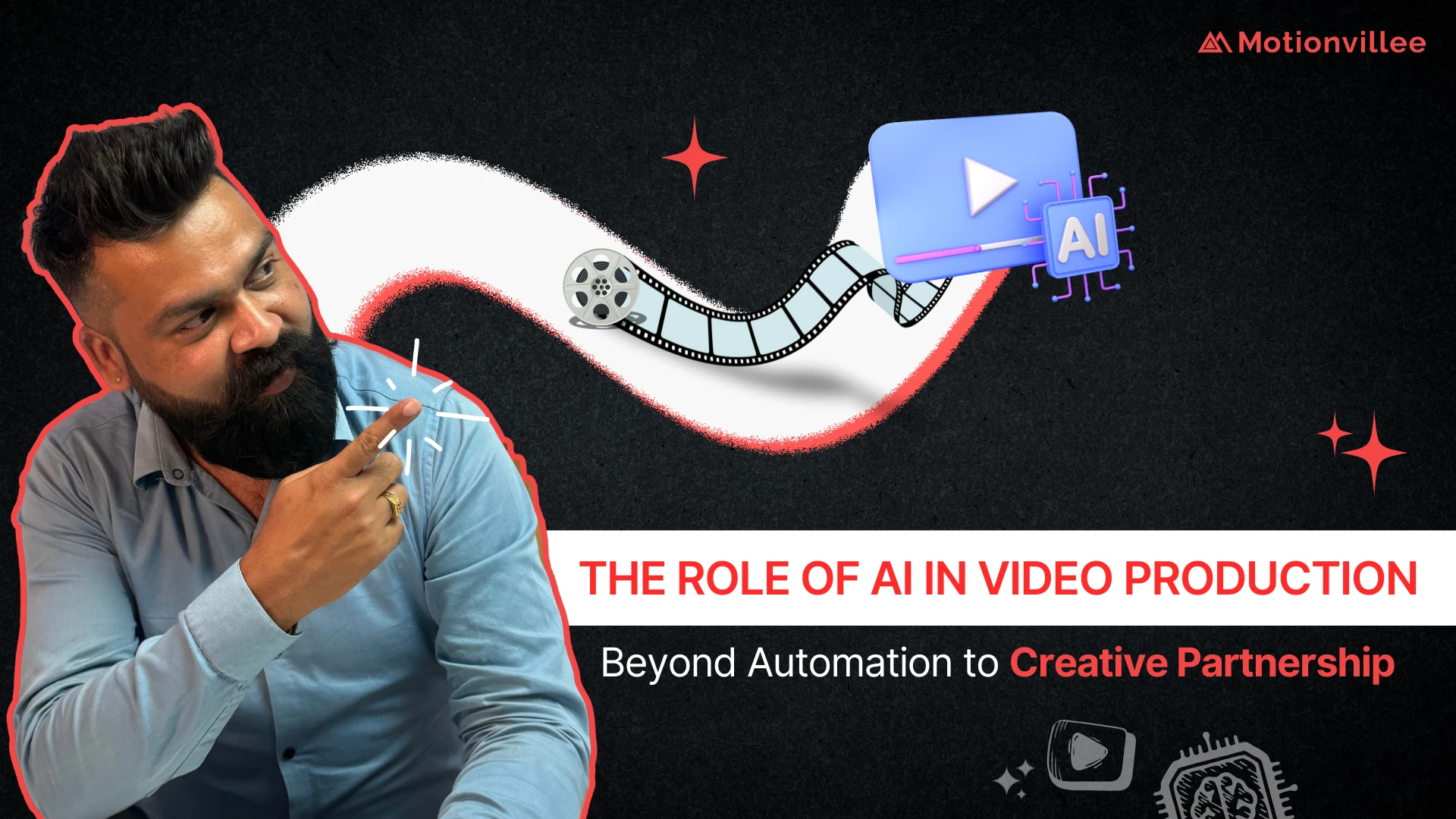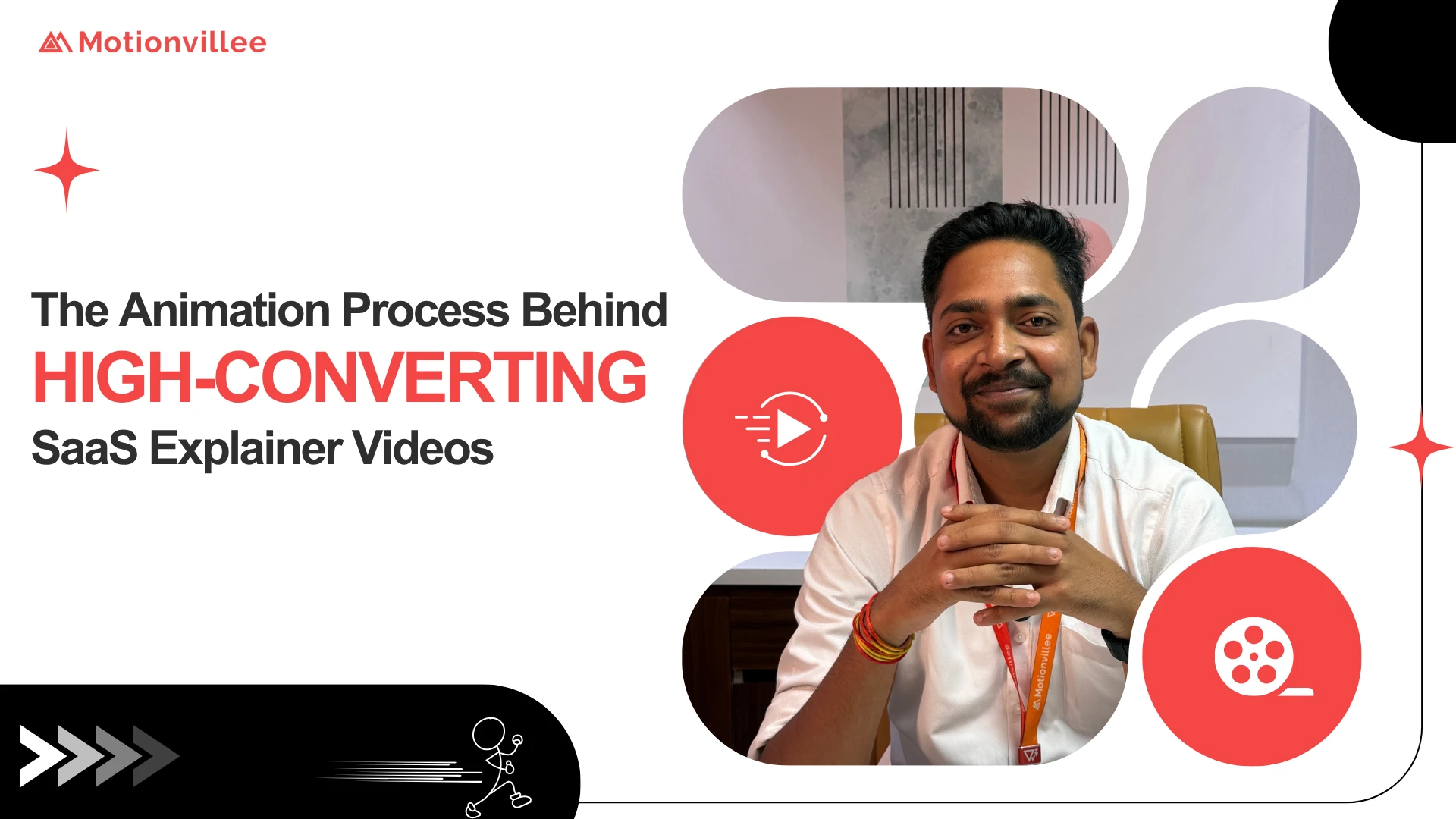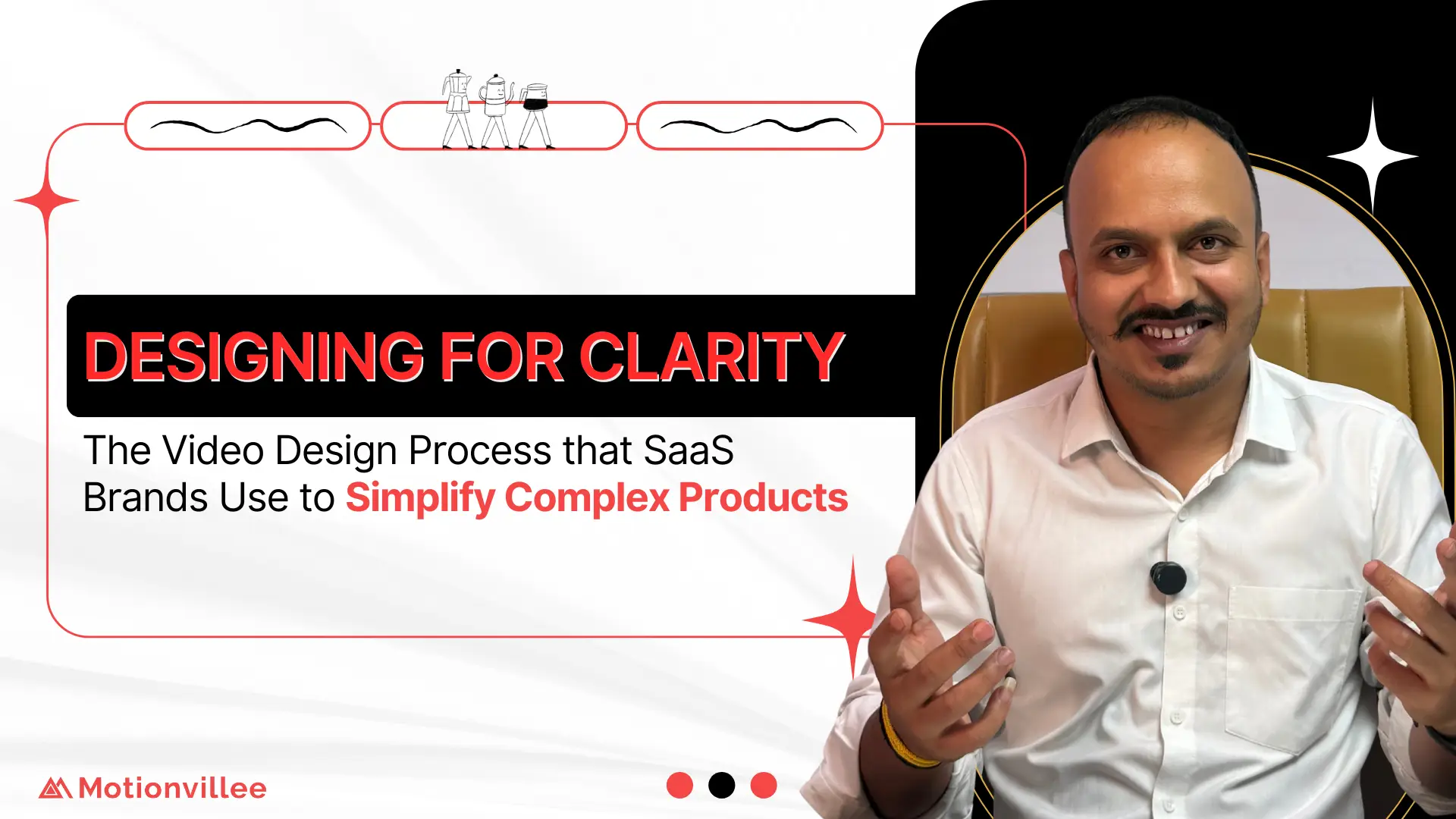27 Ways to Repurpose One Product Demo Video Across Your Funnel
You Spent $20K on One Video. Now Make It Work 27 Times Harder.
Your marketing team invested $20,000 in a professional product demo. It launched on your homepage, generated some views, and now sits unused in a folder. This single use approach means each view cost you significantly more than it should have.
The ability to repurpose product demo video across multiple channels and funnel stages transforms economics entirely. Instead of $20,000 for one deployment, you get $740 per use when that same asset serves 27 different purposes. The video you already own becomes a strategic resource working continuously across years and channels.
This guide presents 27 specific ways to deploy your product demo throughout awareness, consideration, decision, and retention stages. Each deployment requires minimal additional investment while multiplying the return on your original production spend. The framework turns single use assets into multi year, multi channel revenue drivers.
Why Do Most Companies Under-Utilize Their Video Assets?
Companies create videos for specific campaigns without considering multi channel deployment, treating expensive assets as disposable single use content instead of strategic resources.
The single use mindset comes from traditional content creation where each piece serves one purpose. Blog posts go on the blog. Social graphics go on social. Videos get the same treatment despite costing 10-20x more to produce. This approach wastes the inherent versatility that makes video valuable.
Lack of video repurposing strategy during production planning means teams don’t consider multiple use cases when scripting and filming. They optimize for one channel without thinking about how the same content could serve sales, support, and marketing simultaneously. This planning gap costs companies thousands in unnecessary additional production.
Siloed teams compound the problem. Marketing creates videos that sales never sees. Product teams film demos that customer success doesn’t know exist. Each department creates redundant content because they don’t share assets or coordinate distribution across the organization.
Missing distribution workflows mean even when teams want to reuse content, they lack systems to do so efficiently. No one owns the repurposing process. Assets live in scattered folders without clear naming, tagging, or access protocols. The friction of finding and deploying existing videos often exceeds the perceived effort of creating new ones.
The cost comparison reveals the waste. Creating 27 separate videos for different purposes would cost $540,000 at $20,000 each. Repurposing one video 27 ways costs $20,000 plus minimal editing and distribution labor. Companies that don’t maximize existing assets effectively spend 27x more than necessary.
What Makes Product Demo Videos Ideal for Repurposing?
Product demo videos contain evergreen content including features, workflows, and benefits that remains relevant across funnel stages and channels, making them uniquely suited for multi use deployment.
Evergreen versus timely content defines repurposing potential. Announcement videos become outdated within weeks. Event recaps lose relevance immediately. Product demo video content stays valuable because it demonstrates functionality that doesn’t change significantly quarter to quarter. This longevity justifies aggressive repurposing.
Feature demonstrations work equally well for awareness and decision stages by adjusting context and length. A 3 minute full demo educates prospects deeply during evaluation. That same demo cut into 30 second clips highlighting specific problems drives awareness on social media. The content serves both purposes without modification beyond editing.
Educational value persists across the buyer journey because different prospects need the same information at different stages. Early stage buyers want to understand what your product does generally. Late stage buyers want to see specific workflows relevant to their use case. One comprehensive demo addresses both needs through strategic segmentation.
Technical depth serves multiple audience needs simultaneously. Technical evaluators need detailed workflow demonstrations. Business buyers need outcome focused summaries. The same comprehensive demo provides both when you extract relevant segments for each audience. Professional product demo video production that includes this depth enables extensive repurposing across technical and business audiences.
ROI amplification through strategic reuse changes video economics fundamentally. Each additional deployment adds marginal value with minimal cost. The 10th use generates nearly as much value as the first use but costs almost nothing to execute. This compounding return makes demo videos the highest leverage content investment most B2B companies can make.

How Do You Use Demo Videos for Top-of-Funnel Awareness?
Extract 30 to 60 second clips highlighting specific problems your product solves, post them across social platforms with captions, and use them in paid ads to drive initial traffic.
Awareness stage video deployment focuses on problem identification rather than solution details. Prospects at this stage don’t know you exist and may not fully understand they have a solvable problem. Short clips that dramatize the pain point and hint at solutions work better than full product demonstrations.
Ways 1-9: Awareness Stage Deployments
1. LinkedIn organic posts with problem focused clips: Extract 45 second segments showing a specific workflow problem. Add captions describing the frustration, post 2-3 times weekly. LinkedIn’s algorithm favors native video, generating 5x more engagement than link posts while building brand awareness with your target audience.
2. YouTube pre-roll ads targeting keywords: Use 30 second clips as skippable ads before competitor videos and industry content. Target keywords your prospects search when experiencing problems your product solves. YouTube ads cost $0.10-$0.30 per view, making this affordable awareness building.
3. Facebook and Instagram paid ads with captions: Square crop your demo into 1:1 format for feed placement. Add bold captions because 85% of social video plays without sound. Facebook’s detailed targeting reaches specific job titles and company sizes, generating qualified awareness traffic to your website.
4. Twitter video posts for engagement: Post 30 second clips with compelling hooks in the first 3 seconds. Twitter video posts generate 10x more engagement than text, keeping your brand visible to prospects who follow industry hashtags and conversations.
5. Blog post embeds for SEO and engagement: Embed relevant demo clips within blog posts explaining problems your product solves. Video increases time on page by 80%, improving SEO rankings while educating readers. This dual benefit makes blog embeds a high value deployment.
6. Email newsletter featured content: Include demo clips in your monthly or weekly newsletter. Video in email increases click through rates by 200-300%. Subscribers already know your brand, making them receptive to product education that moves them deeper into your funnel.
7. Conference booth display loops: Play silent loops of your demo on screens at trade show booths. Booth traffic increases 30-40% when video attracts attention from passersby. The visual movement draws eyes better than static displays, generating more conversations with qualified prospects.
8. Webinar opening demonstrations: Use 90 second demo clips as webinar openers before your live presentation begins. This fills dead air while educating early arrivals and sets context for your topic. Attendees who watch these clips engage more actively during the live session.
9. Podcast episode supplements: Offer your demo as video content supplementing audio podcast appearances. Listeners who want visual context can watch on YouTube while the audio provides the primary experience. This expands your reach across both audio and video platforms. A saas explainer video works particularly well here because podcast audiences often include technical buyers who appreciate visual demonstrations.
How Do Demo Videos Support Mid-Funnel Evaluation?
Full length demos help prospects compare solutions by showing complete workflows, while segmented clips address specific feature questions that arise during evaluation.
Consideration stage video serves prospects actively evaluating multiple solutions. They understand their problem and know software categories exist to solve it. Now they need detailed information to compare capabilities, assess fit, and justify potential investment to stakeholders.
Ways 10-18: Consideration Stage Deployments
10. Sales email sequences with relevant clips: Sales reps send demo clips addressing specific prospect questions after discovery calls. If a prospect asks about reporting capabilities, the rep sends a 90 second clip showing just that feature. This targeted approach provides immediate value while keeping your solution top of mind.
11. Product comparison pages showing workflows: Embed your demo on comparison pages targeting “Your Company vs. Competitor” keywords. Prospects searching these terms are deep in evaluation. Showing your actual product in action while competitors rely on screenshots creates credibility advantages.
12. Case study page supplements: Add demo clips showing how specific customers use your product to achieve results. The combination of customer testimonial plus actual product demonstration proves capability more convincingly than testimonials alone. This social proof plus product proof combination accelerates consideration.
13. Pricing page value demonstration: Prospects visiting pricing pages are qualified and ready to evaluate investment. Embed a demo clip above pricing tiers showing value delivered for the investment required. This justifies cost by demonstrating capability, reducing sticker shock and increasing demo requests.
14. FAQ video answers to common questions: Record yourself answering frequent questions while showing relevant demo footage. “How does your product handle X?” gets answered with both verbal explanation and visual demonstration. These video FAQs reduce sales burden while providing better education than text answers. A saas product demo video is particularly effective here because technical questions require visual answers.
15. Competitor comparison content: Create videos comparing your demo footage to competitor screenshots or marketing claims. Visual comparison proves capability differences more powerfully than written feature matrices. Prospects see actual product experiences rather than theoretical feature lists.
16. Feature specific landing pages: Build landing pages for each major feature, embedding demo clips showing just that functionality. Prospects searching “software with X feature” land on pages with immediate visual proof you offer what they need. This targeted approach converts high intent search traffic efficiently.
17. Nurture campaign educational content: Automated email nurture sequences include demo clips teaching prospects about capabilities they may not know they need. A prospect who downloaded a whitepaper receives a series of emails, each featuring different demo segments. This progressive education moves them toward conversion over weeks.
18. Sales presentation supporting slides: Sales reps embed demo clips directly into their PowerPoint or Google Slides presentations. Instead of describing what the product does, they show it during discovery calls and demos. This visual support keeps prospects engaged while ensuring accurate representation of capabilities across the entire sales team.
How Do Videos Close Deals in Final Decision Stages?
Prospects need final reassurance before purchase, and demo videos address last minute objections, show implementation simplicity, and provide shareable content for internal stakeholders.
Decision stage video overcomes the final hurdles between evaluation and contract signing. At this point, prospects like your product but need to secure internal buy in, confirm specific requirements, or resolve lingering concerns. Funnel stage content at this level focuses on de-risking the decision through proof, clarity, and stakeholder enablement.

Ways 19-24: Decision Stage Deployments
19. Proposal attachments for stakeholder sharing: Include your demo as a proposal attachment that your champion can share with executives who weren’t involved in earlier conversations. These stakeholders need quick product understanding to approve purchase. A 2 minute demo in the proposal document provides that context without requiring additional meetings.
20. Security and compliance demonstration clips: Extract segments showing security features, access controls, and compliance capabilities. Enterprise buyers must verify these requirements before purchase. Dedicated clips addressing InfoSec concerns accelerate the security review process that often delays contracts by weeks.
21. Implementation preview videos: Show clips of your product’s setup process, data import workflows, and configuration options. Prospects worry about implementation difficulty and timeline. Demonstrating simplicity reduces perceived risk and accelerates decision making by showing that getting started isn’t as complex as they fear.
22. ROI calculator supporting content: Embed demo clips in your ROI calculator tool showing features that drive the value metrics you’re calculating. When your calculator projects $200,000 annual savings, supporting demo footage proves the functionality that delivers those savings actually exists and works as claimed.
23. Final objection handling in sales calls: Sales reps queue up specific demo segments addressing last minute concerns during final calls. If a prospect worries about a specific integration or workflow, the rep shares their screen showing exactly that functionality. This visual proof overcomes skepticism that verbal explanations cannot.
24. Contract negotiation supporting materials: During pricing discussions, reference demo clips showing premium features that justify higher tier investments. When prospects question value differences between packages, showing the actual capability gap through video segments makes the distinction clear and justifies premium pricing.
How Do Demo Videos Drive Customer Success?
Existing customers use demo videos for onboarding, training, and feature discovery, reducing support burden while accelerating time to value and adoption.
Customer retention depends on rapid value realization and ongoing feature adoption. Demo videos solve both challenges by providing self service education that customers can access on demand without opening support tickets or scheduling training calls. Customer onboarding video content reduces your support burden while improving customer experience.
Ways 25-27: Retention Stage Deployments
25. Customer onboarding sequences: New customers receive automated email sequences including demo clips teaching essential workflows. Day 1, Account setup demonstration. Day 3 First workflow walkthrough. And Day 7 Advanced feature introduction. This progressive education gets customers productive faster without consuming customer success manager time.
- Video based onboarding reduces time to value by 40-50% compared to written documentation. Customers watch workflow demonstrations and replicate what they see rather than interpreting written instructions. This visual learning accelerates adoption and reduces early churn risk from customers who struggle to get started.
26. Feature adoption campaigns for existing users: Target customers not using specific features with email campaigns featuring demo clips showing those capabilities. Usage data identifies customers who would benefit from underutilized features. Send them focused 60 second clips demonstrating the feature with clear use cases and quick start instructions.
- Feature adoption campaigns increase expansion revenue by exposing customers to capabilities that drive upgrade purchases. Customers who adopt more features experience more value, reduce churn probability, and become stronger candidates for upsells into higher tiers with additional functionality.
27. Support documentation and help center articles: Embed relevant demo clips in your knowledge base articles. Written instructions explain steps while embedded video demonstrates execution. This combination serves different learning styles and reduces support ticket volume by 30-40% as customers find visual answers to common questions.
- Help center videos also reduce ticket resolution time when customers do contact support. Agents send article links containing video demonstrations rather than typing lengthy explanations. Customers watch the video, resolve their issue, and close the ticket faster than traditional text based support exchanges.
What Technical Formats Enable Maximum Repurposing?
Deliver videos in multiple formats including full length, 60 second clips, 30 second clips, GIFs, and thumbnails with master files containing separate audio tracks and graphics layers for easy editing.
Technical preparation during initial b2b video production determines repurposing flexibility. When you receive only a final rendered video file, creating variations requires expensive professional editing. When you receive source files with separated elements, your team can create derivative content quickly and affordably.
Essential file formats and specifications:
Request master files in high resolution formats (4K or 1080p minimum) that allow quality at any output size. Receive separate audio tracks, music beds, voiceover files, and graphics layers. This modular structure lets you swap elements, create variations, and update specific components without full reproduction.
Include caption files in multiple formats including SRT, VTT, and burned in versions for platforms with different requirements. Professional captions dramatically improve accessibility and engagement, but only if you have them in formats each platform accepts. Request all variations during initial production.
Create aspect ratio versions for different platforms: 16:9 for YouTube and websites, 1:1 square for Instagram and Facebook feeds, 9:16 vertical for Stories and TikTok. Producing these during initial editing costs less than creating them later. Having all ratios ready enables immediate deployment across any channel without delay.
Prepare resolution options for different uses including high resolution for presentations and events, web optimized for fast loading, and mobile optimized for app experiences. File size impacts loading speed, which affects engagement. Right size files for each deployment prevents unnecessary quality loss or load time issues.
Generate still frames and GIFs from key moments for use in static contexts like blog thumbnails, social posts, and email headers. These static derivatives maintain visual consistency while working in formats where video isn’t supported or appropriate.
How Do You Create a Video Distribution Workflow?
Successful repurposing requires documented workflows assigning ownership for each deployment, scheduled publication calendars, and performance tracking across all 27 uses.
Multi channel video deployment needs systematic processes or it doesn’t happen. Individual contributors won’t spontaneously remember to use video across 27 touchpoints without clear ownership, schedules, and accountability. Video distribution workflows transform good intentions into consistent execution.

Distribution checklist by funnel stage:
Create spreadsheets listing all 27 deployment opportunities with assigned owners, publication frequency, and performance targets. Marketing owns social posts and paid ads. Sales owns email sequences and presentation materials. Customer success owns onboarding and support content. Clear ownership prevents assumptions that someone else will handle deployment.
Establish team responsibilities with specific individuals accountable for each channel. Sarah owns LinkedIn posting on Tuesdays and Thursdays. James ensures sales presentation decks include current demo clips. Maria refreshes help center articles quarterly with updated videos. Named responsibility creates accountability that generic team ownership never achieves.
Integrate video deployment into your content calendar alongside other marketing activities. Video isn’t separate from your content strategy. It’s part of it. Schedule specific posts, emails, and updates featuring video assets just as you schedule blog posts and social graphics. This integration ensures consistent execution.
Implement video asset management systems that make finding and using videos easy. Tag videos by topic, funnel stage, and use case. Store them in accessible shared drives or dedicated asset management platforms. If finding video requires asking someone where files live, friction will prevent regular use.
Build performance tracking dashboards showing views, engagement, and conversions across all deployments. Track which channels drive the most value to optimize future distribution. Video repurposing only improves when you measure what works and double down on highest performing channels.
What Metrics Prove Video Repurposing ROI?
Calculate cost per use by dividing production cost by number of deployments, track performance by channel, measure cumulative impact on pipeline, and compare to creating separate videos.
Demo video ROI measurement starts with basic cost per video use economics. Divide your $20,000 production investment by 27 deployments to get $740 cost per use. Compare this to creating 27 separate videos at $20,000 each totaling $540,000. The repurposing approach costs 96% less while delivering similar or better results.
Cost per deployment calculation:
Track actual hours spent on each deployment including editing time, upload labor, and distribution effort. If creating a social media clip requires 2 hours at $75/hour, add $150 to the base $740 cost for $890 total cost per deployment. This full accounting still shows massive savings versus separate production while providing accurate ROI data.
View and engagement metrics by channel reveal which deployments drive the most value. Homepage video might generate 5,000 monthly views. LinkedIn posts add 2,000 views. Sales emails contribute 1,500 views. Aggregate these to show total monthly impact, then calculate cost per view across all channels combined for true efficiency measurement.
Conversion attribution across touchpoints requires tracking which video exposures lead to pipeline. Use UTM parameters on video landing pages, track email click throughs to demo requests, and survey new customers about content that influenced their decision. Multi touch attribution shows video’s cumulative influence across the buyer journey.
Pipeline influence measurement connects video engagement to revenue outcomes. Analyze whether prospects who watch videos convert at higher rates, close faster, or generate larger contracts than those who don’t. These business outcome metrics prove video’s strategic value beyond vanity metrics like views.
ROI comparison between repurposing versus new production makes the business case undeniable. Show executives that getting 50,000 total views from one repurposed video cost $20,000 while getting 50,000 views from 27 separate videos would cost $540,000. The 27x cost difference with similar reach makes the strategic case for systematic repurposing overwhelming.
How Do You Keep Repurposed Content Fresh?
Update intro and outro cards quarterly, refresh statistics and claims annually, and add new use cases without full reproduction to extend asset lifespan to 18-24 months.
Video content refresh strategies determine asset longevity. Most demo videos remain 80% relevant for 18-24 months. Core features don’t change dramatically. Workflows stay consistent. The surrounding context dates faster than the core content, making targeted updates more efficient than complete reproduction.
When to update versus create new:
Update existing videos when core content remains accurate but supporting elements need refreshes. Customer counts, awards, and statistics go stale quickly. Modular production that separates these elements from core demo footage enables easy updates. Replace opening cards showing outdated metrics without touching the product demonstration itself.
Create new videos when product changes make existing demos misleading or when interface updates make old footage look dated. Major redesigns and significant feature launches justify new production. Minor UI tweaks and incremental improvements don’t warrant starting over.
Modular editing approach during initial production enables efficient updates. Separate intro sequences, product demonstrations, and outro sections into distinct video segments. This structure allows swapping updated intros onto existing demos without re editing the entire video. Request this modular structure from your production partner initially.
Version control and dating systems help teams track which video version is current for each deployment. Name files with version numbers and dates: ProductDemo_v2_2024Q1.mp4. Maintain a master spreadsheet showing which version is live in each channel. This prevents accidentally deploying outdated assets after updates.
Communicate updates to distribution teams immediately when new versions launch. If customer success is using Q1 onboarding videos in Q3, they need notification that updated versions exist. Slack announcements, email notifications, or shared calendar reminders ensure everyone deploys current content.
Lifespan optimization balances freshness with production efficiency. Plan for major updates every 18-24 months and minor refreshes every 6 months. This cadence keeps content current without excessive production costs. The investment in updates remains fraction of creating 27 separate videos annually.
27 Uses Transform $20K Into $740 Per Deployment
The cost per use economics make repurposing product demo video across your funnel financially obvious rather than optional.
Strategic planning during initial production enables efficient repurposing. Request modular source files, multiple aspect ratios, separated audio tracks, and comprehensive caption files. These technical specifications cost minimally more upfront but unlock 27 uses that would otherwise require expensive editing or remain impossible.
Position video as multi year, multi channel assets that work continuously across awareness, consideration, decision, and retention stages. One comprehensive demo created with repurposing in mind serves your entire organization for 18-24 months. Marketing uses clips for paid ads and social content. Sales embeds segments in presentations and emails. Customer success deploys tutorials in onboarding and support.
Contrast this systematic approach with single use waste where expensive video assets launch once, generate initial views, then sit unused. Companies that repurpose product demo video strategically extract 27x more value from the same investment, creating sustainable competitive advantages in markets where video production budgets limit most competitors to minimal deployment.
Ready to plan a multi use video strategy that maximizes every production dollar? Schedule a call with Motionvillee to discuss how to structure your next demo for deployment across all 27 touchpoints throughout your funnel. We’ll help you build the technical specifications, source files, and distribution workflows that transform single use assets into strategic revenue drivers.RetryClaude can make mistakes. Please double-check responses.Himanshu Sonnet 4.5







